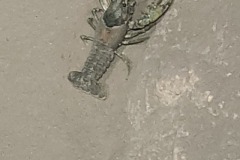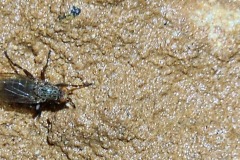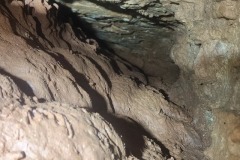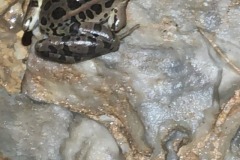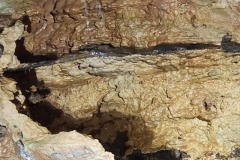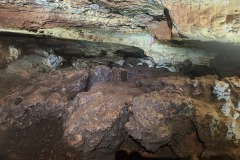Stark Caverns Photo Trip Report
10 September 2023
Bill Gee
Tristin Whetstine
Mike Kovacs
Candace Kovacs
Chloe Kovacs
On past photo trips we have covered most of Stark Caverns. The last area to be photographed was the Rugged Canyon. This is the longest and most difficult of the side passages in Stark Caverns.
Candace Kovacs was our main photographer. Her smartphone does an amazing job with cave photography. Tristin Whetstine had a GoPro on his helmet, and Mike Kovacs took some photos with his smartphone. All of us carried spare bright lights for illuminating the cave. Slave flash units do not work well with a smart phone camera, so we used very bright flashlights. That turned out well. We had a lot of lights which made placement very flexible. They are smaller and easier to carry than slave flash units.
The group met at the visitor center parking lot at about 8:00am Sunday morning. A group of Girl Scouts had camped overnight in the cave, so the gates on the road and at the cave were already open. Our group geared up and was ready to go caving by about 8:30am.
I had requested that some liability waivers be left out at the counter. Stark Caverns staff looked around but could not find anything. Four of us had signed a makeshift waiver about 5 weeks previous, so we did not spend much time on it.
As we went down the tour trail we kept an eye on the ponds and stream. The stream flow was almost nothing. The water at the front of the cave was fairly murky, but further back it was very clear. We saw numerous crayfish ranging from about 6 centimeters up to around 12 centimeters long. These crayfish were pale colored but not troglobytic. We also saw a few frogs.
We dropped clean shoes and a tarp just off the tour trail near the wishing Well. This is the entrance to the Rugged Canyon. The first stand-up room has a small pool in it where we saw one larval salamander a bit over one centimeter long.
From there the Rugged Canyon lives up to its name. The passage is very narrow with many tight turns and squeezes to get through. The first 300 feet or so takes 20 to 30 minutes. We arrived at the Halfway Room around 9:30am. There are some formations here and a small drip puddle. There is a very small passage leading out that is not human passable. Mike thinks it can be dug out since it is mostly clay fill. Candace took a few photos looking down it. We can see 15 or 20 feet, and it looks like it might get a bit larger.
After Candace finished, we continued on. The passage drops down through a hole to get to the stream level. From there is a bit of crawling, then we are in stand-up passage. The passage is fairly wide at the floor where the stream has undercut the rock. Most of that is six inches or less. The human-passable part is 10 to 15 feet high and one or two feet wide. There is a high room on one side. Candace spent a lot of time getting good photos of this area.
The waterfall is just past the high room. As expected, it was not flowing much at all. A garden hose can deliver more water. Tristin used some of his rock climbing skills to get out over the pond at the base of the waterfall while not stirring up the mud. Candace took a lot of photos of the area.
As we were heading out, I saw a crayfish in the pool. It was 12 to 15 centimeters long. We also saw several frogs around the pool. There was an adult cave salamander (Eurycea lucifuga). On the way out we mentioned the salamander to several of the tour guides, and they said that species is often seen in a few places along the tour trail.
The passage splits here. One arm contains the waterfall and the other has a bunch of stromatolites on the floor. Those are interesting formations, so we took quite a few photos in that area.
Beyond that the passage gradually gets lower. We crawled and belly-crawled all the way to a fork where the last survey station is. The two forks might be passable for 20 feet but then get too tight for humans. It would in any event be a belly crawl in water which pretty much requires a wet suit. We noticed a fair breeze blowing out of the left fork. If it blows, it goes! There is probably a lot of cave beyond that. It is worth a bit of pushing by a team of very small explorers.
We also noticed a joint going across the two forks. It is large enough to stand up in, and the top of it is 15 feet or so above the floor. I need to add this feature to the map.
The room just upstream of the waterfall is a good lunch place. We took a break to have some food, then started out. Candace had one more area she wanted to photograph. Unfortunately her phone battery ran out. We will have to do another trip to get that. If we plan it right, we can catch the waterfall in flow.
We were out of the cave about 1:30pm. We changed to clean clothes, checked out with the staff, then went to Si Señors in Eldon for a late lunch.
The critter count was 15 crayfish, one cave salamander, one larval salamander, some flying bugs similar to gnats, a few flies and 5 frogs.

